ECONOMICS:
A. DURING FASCISM
- The Nazi camp system expanded rapidly after the beginning of World War II as forced-labor became important in war production. Labor shortages in the German war economy became critical after German defeat in the battle of Stalingrad in 1942-1943. This led to the increased use of concentration camp prisoners as forced laborers in German armaments industries. Especially in 1943 and 1944, hundreds of subcamps were established in or near industrial areas and major cities. Camps such as Auschwitz in Poland, Buchenwald in central Germany, and Transnistria Labor Camp at the border of Romania and the Ukraine, served as forced-labor camps.
- Based on an economic system, Germany used cheap labor and forced the labor of humans as their economic source to work rather than to transport them all to death camps. The German phrase, “ARBEIT MACH FREI” (WORK MAKES FREEDOM) was the slogan printed at the front door entrance to the work camps.
- Romania was rich in oil, which was needed by the German Army as they conquered territories going eastward, especially towards St. Petersburg. Romania traded their oil to Germany on a barter system. In return, General Antonescu was allowed a free reign to handle his Jewish population as he wished – sometimes savagely, and sometimes ambiguously as with the “Bucharest” Jews.
- Romania was also rich in natural gas and wheat. Both became important staples for the German Reich.
B. DURING COMMUNISM:
- Ceausescu had a “hands-on” control of the economy. All natural resources were government owned, meaning Ceausescu-owned. And all private companies were taken over by the government.
- Romania’s foreign debt sharply increased between 1977-1981, and the dictator initiated a total reimbursement of the foreign debt by imposing policies that impoverished Romanians. When Ceausescu was executed, there was a zero foreign debt in Romania. Ceausescu had paid for everything in cash, being that he was doing all his business deals with foreign countries in cash.
- Ceausescu, despite being a Communist and leader of the Communist party in Romania, was the richest man in Eastern Europe during his reign. (1965-1989) He was involved in horrific schemes with the sole intention of personal profit and wealth.
- In “The Gift of Diamonds,” Mica learns about Ceausescu’s business deals while she is working in the American Embassy in Budapest. What she hears is based on FACTS:
1. CEAUSESCU AND NUCLEAR ARMS:
- Lt. General Ion Pacepa, Ceausescu’s chief of Foreign Intelligence, writes in his memoir, Red Horizons, on p. 21, that in 1968, “Two Romanian nuclear specialists defected to the West and found employment in Canada’s nuclear facility, AECL, the Atomic Energy of Canada, on the reactor project, CANDU. Ceausescu saw the perfect solution for making Romania an exporter of atomic power plants, uranium, and heavy water throughout the Third World.”
- Pacepa writes in Red Horizons, p. 294, “On November 19, 1977, Romania also signed an agreement with Canada to buy parts for one or two nuclear reactors to be built in Cernavoda as a model for promoting Romanian export of nuclear power plants.”
- “Rate of Nuclear Thefts Disturbingly High, Monitoring Chief says,” The New York Times, by Neil MacFarquhar, October 28, 2008, p. A4, “Mohammed El Baradei, United Nations Chief of the International Atomic Energy Agency, claims there is a great number of nuclear and radioactive material stolen by countries of the former Soviet bloc.”
- While researching for “The Gift of Diamonds,” I found in the United Nations library a letter dated July 2, 1992 addressed to Hans Blix, the Director General of the U.N. International Atomic Energy Agency. The letter stated that under the former regime in Romania, Ceausescu had established, “lab-scale research studies on nuclear fuel and plutonium” that had not been reported to the IAEA.
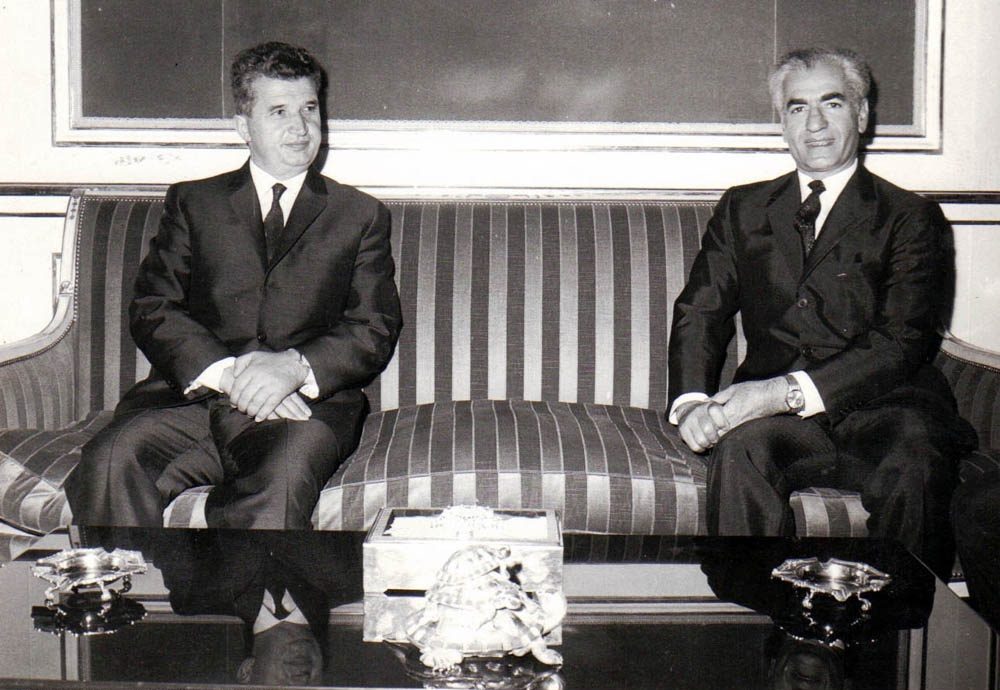
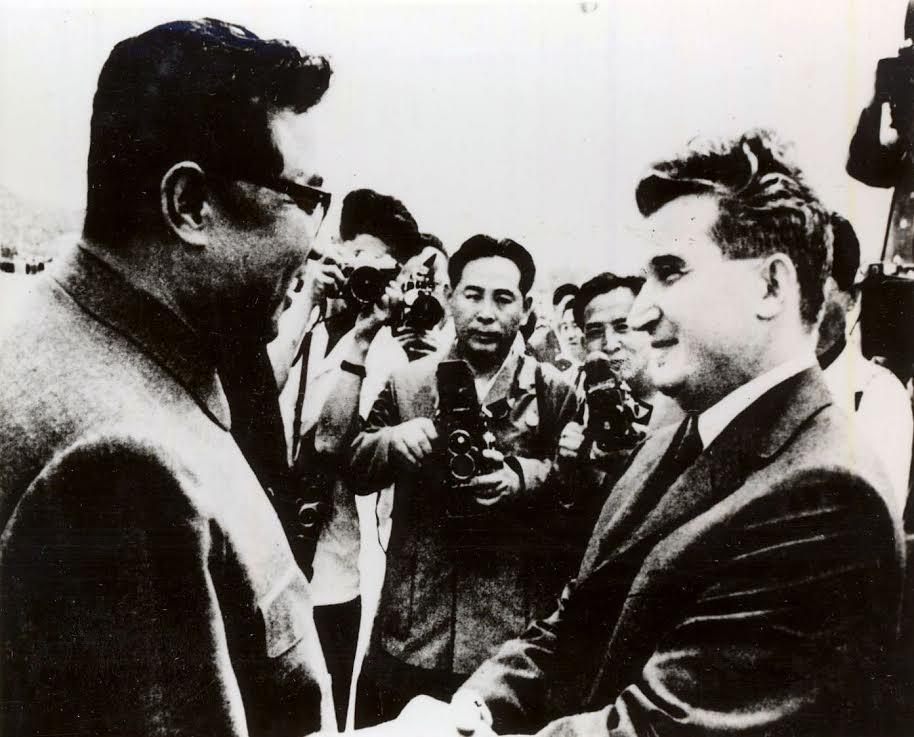
2. CEAUSESCU AND ARAFAT:
- As of 1972 Arafat and Ceausescu began extensive meetings in Romania. In 1976, Ceausescu and Arafat agreed to exchange intelligence advisors. The PLO nominated Hani Hassan (who was in charge of the massacre of eleven Israeli Olympians at the September 5, 1972 Olympics in Munich). Ceausescu sent Ion Pacepa to represent Romania.
- It was Ceausescu who gave Arafat the idea to transform the PLO into a Palestinian government-in-exile in Tunisia (1982-1993). Ceausescu advised Arafat, “It would be much easier to persuade the West to negotiate with a government-in-exile than with a terrorist organization… When I get to Washington, I want to put it to Carter that I, and only I, can change the PLO, and that I am willing to do so, if he agrees to transfer the negotiations from Camp David to Geneva.” Red Horizons, by Ion Pacepa, p.27.
- Clearly Ceausescu’s idea to create Arafat as a chameleon was to endorse peace. But his true motive was to destroy Israel. Yasser Arafat received the Nobel Peace Prize for Peace in 1994 with Prime Minister of Israel Rabin and Shimon Peres.
- “The KGB Man,” Wall St. Journal, by Ion Pacepa, September 22, 2003, describes how Ceausescu and Pacepa created an image for Arafat with the blessings of the KGB and how Arafat went on to be a career terrorist. Click here to download PDF article.
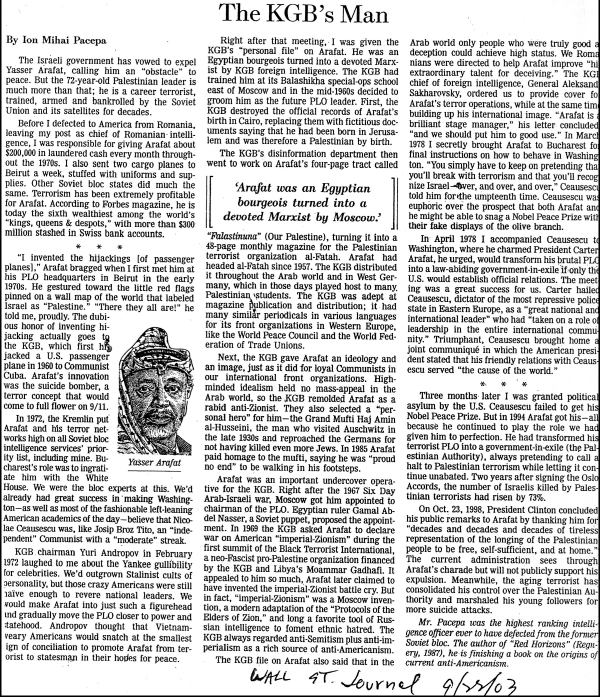
3. CEAUSESCU AND GADDAFI:
- Gaddafi and Terrorism (click to read WikiLeaks Article)
- Photo of Gaddafi and Ceausescu in Tripoli 1974
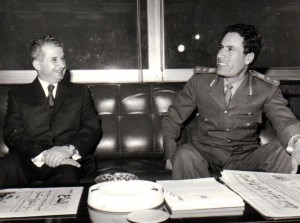
- With Gaddafi’s money, Ceausescu sent his agricultural experts to construct farms all over Libya in the 1970’s and made a fortune and a friend. Red Horizons, by Ion Pacepa, p. 101.
- Stolen passports were an important link between Ceausescu, Gadaffi and Arafat. In order to stage terrorist acts abroad without involving Tripoli directly, the Libyan government amassed passports that were stolen from workers in Tunisia as well as forged passports made by Ceausescu’s experts. (Arafat and the PLO’s were in exile in Tunisia during this period)
- The New York Times article, “Hostages Sought, Vienna Gunmen Say,” by Paul Lewis, December 31, 1985, p. A 4, “The Libyans are to this day organizing terrorist missions with the help of this passport collection. The terrorists who made an attack at the El Al checkout counter in the Vienna airport on December 27, 1985 were traveling with stolen Tunisian passports. Several hundred Tunisian passports were confiscated recently by the Libyans from Tunisian workers.”
- Ceausescu and Gaddafi were also business partners with oil. “Ceausescu set up an oil refinery on the Black Sea to process only Libyan crude oil with the products to be exported as Romanian – as a safety valve for Gaddafi, in case of a western boycott of Libyan oil.” Red Horizons, by Ion Pacepa, p. 105.
- Ceausescu and Gaddafi established joint ventures to manufacture tanks based on Germany’s Leopold II, airplanes as the Fokker-614, and bacteriological weapons. Ceausescu wanted the site to be secret. “The tank assembly line should not be in Bucharest but hidden in a mountainous area.” Red Horizons, by Ion Pacepa, p.369.
4. CEAUSESCU AND ZULFIKAR ALI BHUTTO:
- In 1975, Bhutto was Pakistan’s Prime Minister and the leader behind Dr. Abdul Qadeer Khan’s ascent to become Pakistan’s “Father of the Nuclear Bomb.” (The New York Times, November 5, 2004; The New York Times, November 24, 2004; Time magazine, “The Merchant of Menace,” February 14, 2005, pp. 22-30.
- Ion Pacepa describes Ceausescu and Bhutto’s friendship: “In 1975 I showed Ceausescu’s DIE (Romania’s Espionage Agency) information indicating that Pakistan was conducting ultra-secret operations to develop its own military nuclear capability. That was also Ceausescu’s secret dream.” Red Horizons, by Ion Pacepa, pp. 300-302.
- Bhutto and Ceausescu met for the first time in Karachi in 1975. Pacepa recounts the meeting: Ceausescu began, “You and I share the same dream… and the best way to do that is to build up our power. In our day the only real power is nuclear power. We should build it secretly. … In this envelope is a sample of what we can do. Bhutto carefully put the envelope into his pocket. It contained an inventory of the nuclear intelligence information Romania could secretly provide to Pakistan… Four weeks after this encounter, Radu Andreescu, an engineer working for Ceausescu, went to Pakistan with a voluminous diplomatic pouch containing sensitive nuclear information obtained from the Canadian project of the CANDU reactor as well as French nuclear security systems. He brought back to Romania supplementary intelligence on the Degussa centrifuge system for enriching uranium on which Bucharest was already working, and significant data on the industrial production of Uranium 235.” Red Horizons, by Ion Pacepa, pp. 301-302. (Note: Uranium 235 is an isotope, a form of uranium whose atomic arrangements can generate a nuclear reaction.)
- In 1975, Dr. Khan was working for URENCO in Holland and lived there with his Dutch wife. After one year, they left Holland with stolen blueprints of centrifuges. In 1976, Pakistan with Dr. Khan as the Director of their Nuclear Agency, began building Dutch SNOR centrifuges.
5. CEAUSESCU AND IRAN:
- Ceausescu did business with Iran’s Shah Reza Pahlavi and his brother in the 1980’s.
- On December 17, 1989, Ceausescu and his wife left Bucharest to visit Tehran, despite the beginnings of demonstrations and violence in Timisoara. For two days they stayed in Iran for business purposes. “Romania and Iran were negotiating an arms deal. In addition, Romania was close to sealing an agreement to modernize for Iran all the Warsaw Pact military equipment that Iran secured during the Iran-Iraq War of 1980-88. Romania was also building for Iran a naval base as well as a tractor plant to produce military vehicles. In exchange, Romania was to receive from Iran crude oil and natural gas per year as well as $2 billion worth of contracts.” The Romania Revolution, by Peter Siani-Davies, p. 69.
- When Ceausescu returned to Bucharest two days later, violence and revolution had spread from Timisoara to Bucharest.
6. CEAUSESCU AND DIAMONDS:
- Nicolae and Elena Ceausescu’s fascination with diamonds led them to create a friendship with Jean Bedel Bokassa, Central African dictator, whose country was known for their diamond mines. It all began, “In 1975 they invited Bokassa to make an official visit to Bucharest where they saw to it that he would be shown a good time by a stunning Romanian girl, Gabriela… Because of her, Bokassa secretly accepted 10% of the profits, paid into a Swiss account, from the diamond mines he arranged for Romania to operate…This relationship lasted 2 years and so did Bokassa and Gabriela.” Red Horizons by Ion Pacepa, p.70.
- During this time, Bokassa had another good friend, France’s President Giscard d’Estaing. On October 10, 1979, the French newspaper Le Canard Enchainé reported that President Giscard d’Estaing had accepted two diamonds in 1973 from Bokassa. This erupted into a scandal called, L’Affaire des Diamonds which was followed in early December 1979 by another scandal, the friendship of Bokassa and Gaddafi. Bokassa in 1976, had converted to Islam and had changed his name with the supposition that Gaddafi would bestow financial aid to him and his country. Several months later when aid did not come from Gaddafi, Bokassa converted back to Catholicism.
- It should not be forgotten that Giscard d’Estaing sold Alouette and Mirage planes to Ceausescu. In this way the French President was able to show a surge in the economy and win re-election. He did not inform his voters that the planes were to be used by Arafat and the PLO’s.
- Pacepa tells us theat “In 1975, Ceausescu ordered me to obtain the technology and equipment for producing synthetic diamonds…At the beginning of January 1978 we started industrial production on a large scale.” Red Horizons by Ion Pacepa, p.71.
- Ceausescu told Pacepa, “Your DIE (Espionage Agency) has to sell stars (diamonds) secretly on the Western market – the same way it does with the cocaine in transit from Asia to Europe that we confiscate at the border.” Red Horizons by Ion Pacepa, p.72.
7. CEAUSESCU AND ROMANIAN AND ISRAELI JEWS:
- Ceausescu claimed that “Oil and Jews are our best export commodities.” From the 1950’s to the 1970’s, Israel wanted to get the Romania Jews who had survived the Holocaust to be freed from Communist Romania and emigrate to Israel. The Mossad was amenable to pay for this service by using their middleman, Jacober, to negotiate with Romanian dictators, Gheorghe Gheorghiu-Dej and then Ceausescu. When Jacober died of cancer, the deputy director of Israeli Intelligence for Immigration, a native Romanian with an Israeli diplomatic passport, became Ceausescu’s partner. For these transactions, Ceausescu earned “hundreds of millions of dollars” in cash.
- Israel also supplied Romania with Centurion tanks as part of a barter system. Ceausescu later copied and manufactured these tanks and shared them with his friends.
8. CEAUSESCU AND NORTH KOREA
- Romanian newspaper, International Curentul, April 7, 2005, p. 3A, relates how Ceausescu sold parts of the atomic bomb to dictator Kim Jung II from 1978-1980.
- The New York Times narrates how Kim Jung II sold Libya uranium hexafluoride for nuclear centrifuges.” The New York Times, David E. Sanger, February 2, 2005, p. A1. .“North Korea’s plutonium program dates back to 1986, U.S. official says. (This is during Ceausescu’s era.) There are records for the 5-megawatt reactor and fuel processing plant at the Yongbyon nuclear complex.” Wall St. Journal, “North Korea: Nuclear Program Documents Appear Complete, U.S. says,” May 14, 2008.
9. CEAUSESCU AND IRAQ:
- Secret agents of the Iraqi leader, Saddam Hussein, lived, studied and worked in Romania as part of an Iraqi terrorist network in Romania. “During the Communist era, students (secret agents) came from Iraq, Iran, Sudan and Libya to study in Bucharest. Often they married and stayed… A Romanian arm of al-Dawa smuggles Iraqi defectors out of Iraq, into Romania, and on to western Europe.” The Wall St Journal, “Romania’s Expulsion of Iraqi Diplomat Fuels Suspicion of Baghdad’s Activity in Europe,” by Rick Jarvis.
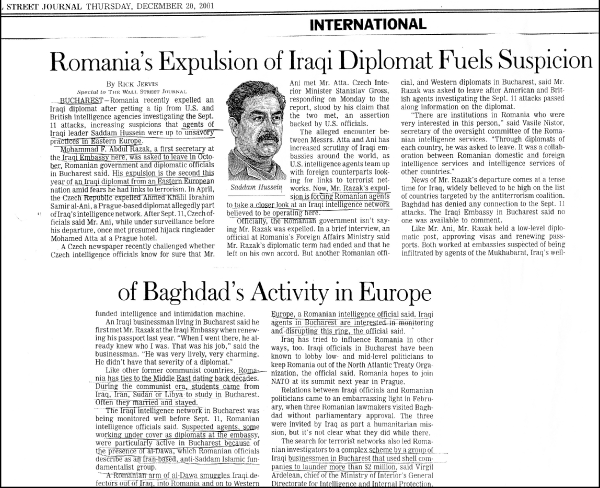
C. ROMANIA TODAY:
- With the fall of the Iron Curtain in 1989, Romania started a series of political and economic reforms.
- It joined NATO on March 29, 2004 and the European Union on January 1, 2007. Prior to that, in 1972 it became a member of the International Monetary Fund and the World Bank. It is also a member of the World Trade Organization.
- In December 2005, President Traian Basescu signed an agreement that would allow a U.S. military presence at several Romanian facilities primarily in the eastern part of the country. (On the Black Sea and in the Carpathian Mountains.) In May 2009, the American state secretary Hillary Clinton declared that “Romania is one of the most trustworthy and respectable partners of the USA” during a visit to Romania.
- The Romanian automobile, Dacia, is one of the top-selling cars in Central and Eastern Europe as well as in Russia. France and Germany have formed joined ventures in car manufacturing with Romania’s Dacia.
- In 2005, the government replaced Romania’s tax system with a flat tax of 16% for both personal income and corporate profit, resulting in the country having the lowest fiscal burden in the European Union.
- The economy is predominantly based on services, which account for 55% of GDP and 35% from industry. 32% of the Romanian population is employed in agriculture.
- Tourism has increased and represents an important commercial income for governmental and private investment.
Romania entered NATO in 2003 and the European Union in 2007. - Bucharest is the capital and largest city with a population of 2 million.
- Romania has become a major partner and ally with the United States as a bulwark against Russia, especially as the annexed Crimea and expanded their influence in the Baltic nations.
- Romania’s GDP has doubled in the past 10 years.
- Romanian government has an anti-corruption department that has actively and legally enforced judicial cases against corruption.
Romania has a strong Internet and Telecommunications sector where they serve as backup offices and partners to global Technology companies and start-ups. - Cities have been improved with infra-structures, construction, services, security, transportation as highways and roads.
- Rural areas have not been improved at the same rate. Factories and industries have closed and have left workers in rural areas unemployed.
- Young people have relocated to urban areas in Romania and in Europe for work. 2.5 million Romanians live and/or work abroad.
Foreign investments have increased, especially with European Union nations, China, Japan and Iran.
Sándor Déki Lakatos–Udvözlö Liszt Ferenchez
